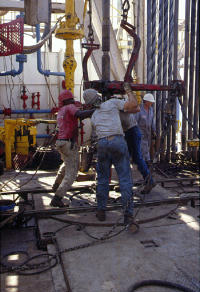| |
Drilling
The crew sets up the rig and starts the drilling
operations. First, from the starter hole, they
drill a surface hole down to a pre-set depth,
which is somewhere above where they think the oil
trap is located. There are five basic steps to
drilling the surface hole:
Place the drill bit, collar and drill
pipe in the hole.
Attach the kelly and turntable and
begin drilling.
As drilling progresses, circulate mud
through the pipe and out of the bit to
float the rock cuttings out of the hole.
Add new sections (joints) of drill
pipes as the hole gets deeper.
Remove (trip out) the drill pipe,
collar and bit when the pre-set depth (anywhere
from a few hundred to a couple-thousand
feet) is reached.
|

Photo courtesy
Phillips Petroleum Co.
Rotary workers trip drill pipe
|
Once they reach the pre-set depth, they
must run and cement the casing -- place casing-pipe
sections into the hole to prevent it from collapsing in
on itself. The casing pipe has spacers around the outside
to keep it centered in the hole.
The casing crew puts the casing pipe in the hole. The
cement crew pumps cement down the casing pipe using a
bottom plug, a cement slurry, a top plug and drill mud.
The pressure from the drill mud causes the cement slurry
to move through the casing and fill the space between the
outside of the casing and the hole. Finally, the cement
is allowed to harden and then tested for such properties
as hardness, alignment and a proper seal.
Drilling continues in stages:
They drill, then run and cement new casings, then
drill again. When the rock cuttings from the mud
reveal the oil sand from the reservoir rock, they
may have reached the final depth. At this point,
they remove the drilling apparatus from the hole
and perform several tests to confirm this finding:
|
New
Drilling Technologies
The U.S.
Department of Energy and the oil
industry are working on new ways
to drill oil, including
horizontal drilling reach oil
techniques, to under ecologically-sensitive
areas, and using lasers to drill
oil wells.
|
|
|
- Well logging - lowering electrical and gas
sensors into the hole to take measurements of the
rock formations there
- Drill-stem testing - lowering a device
into the hole to measure the pressures, which
will reveal whether reservoir rock has been
reached
- Core samples - taking samples of rock to
look for characteristics of reservoir rock
Once they have reached the final depth, the crew
completes the well to allow oil to flow into the casing
in a controlled manner. First, they lower a perforating
gun into the well to the production depth. The gun
has explosive charges to create holes in the casing
through which oil can flow. After the casing has been
perforated, they run a small-diameter pipe (tubing)
into the hole as a conduit for oil and gas to flow up the
well. A device called a packer is run down the
outside of the tubing. When the packer is set at the
production level, it is expanded to form a seal around
the outside of the tubing. Finally, they connect a multi-valved
structure called a Christmas tree t the top of the
tubing and cement it to the top of the casing. The
Christmas tree allows them to control the flow of oil
from the well.
Once the well is completed,
they must start the flow of oil into the well.
For limestone reservoir rock, acid is pumped down
the well and out the perforations. The acid
dissolves channels in the limestone that lead oil
into the well. For sandstone reservoir rock, a
specially blended fluid containing proppants
(sand, walnut shells, aluminum pellets) is pumped
down the well and out the perforations. The
pressure from this fluid makes small fractures in
the sandstone that allow oil to flow into the
well, while the proppants hold these fractures
open. Once the oil is flowing, the oil rig is
removed from the site and production equipment is
set up to extract the oil from the well.
|
Blowouts
and Fires
In the
movies, you see oil gushing (a blowout),
and perhaps even a fire, when
drillers reach the final depth.
These are actually dangerous
conditions, and are (hopefully)
prevented by the blowout
preventer and the pressure of the
drilling mud. In most wells, the
oil flow must be started by
acidizing or fracturing the well.
|
|
|
back
|
|
![]()
![]()